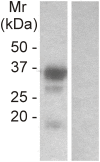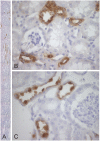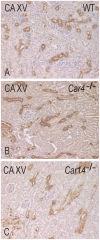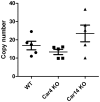The most recently discovered carbonic anhydrase, CA XV, is expressed in the thick ascending limb of Henle and in the collecting ducts of mouse kidney
- PMID: 20224780
- PMCID: PMC2835753
- DOI: 10.1371/journal.pone.0009624
The most recently discovered carbonic anhydrase, CA XV, is expressed in the thick ascending limb of Henle and in the collecting ducts of mouse kidney
Abstract
Background: Carbonic anhydrases (CAs) are key enzymes for physiological pH regulation, including the process of urine acidification. Previous studies have identified seven cytosolic or membrane-bound CA isozymes in the kidney. Recently, we showed by in situ hybridization that the mRNA for the most novel CA isozyme, CA XV, is present in the renal cortex. CA XV is a unique isozyme among mammalian CAs, because it has become a pseudogene in primates even though expressed in several other species.
Methodology/principal findings: In the present study, we raised a polyclonal antibody against recombinant mouse CA XV that was produced in a baculovirus/insect cell expression system, and the antibody was used for immunohistochemical analysis in different mouse tissues. Positive immunoreactions were found only in the kidney, where the enzyme showed a very limited distribution pattern. Parallel immunostaining experiments with several other anti-CA sera indicated that CA XV is mainly expressed in the thick ascending limb of Henle and collecting ducts, and the reactions were most prominent in the cortex and outer medulla.
Conclusion/significance: Although other studies have proposed a role for CA XV in cell proliferation, its tightly limited distribution may point to a specialized function in the regulation of acid-base homeostasis.
Conflict of interest statement
Figures








Similar articles
-
Physiology and molecular biology of renal carbonic anhydrase.J Nephrol. 2002 Mar-Apr;15 Suppl 5:S61-74. J Nephrol. 2002. PMID: 12027223 Review.
-
Carbonic anhydrase XII mRNA encodes a hydratase that is differentially expressed along the rabbit nephron.Am J Physiol Renal Physiol. 2003 Feb;284(2):F399-410. doi: 10.1152/ajprenal.00370.2001. Epub 2002 Oct 8. Am J Physiol Renal Physiol. 2003. PMID: 12388401
-
Roles of cytosolic and membrane-bound carbonic anhydrase in renal control of acid-base balance in rainbow trout, Oncorhynchus mykiss.Am J Physiol Renal Physiol. 2006 Aug;291(2):F407-21. doi: 10.1152/ajprenal.00328.2005. Epub 2006 Mar 28. Am J Physiol Renal Physiol. 2006. PMID: 16571594
-
Expression of a novel carbonic anhydrase, CA XIII, in normal and neoplastic colorectal mucosa.BMC Cancer. 2005 Apr 18;5:41. doi: 10.1186/1471-2407-5-41. BMC Cancer. 2005. PMID: 15836783 Free PMC article.
-
The cellular physiology of carbonic anhydrases.JOP. 2001 Jul;2(4 Suppl):159-64. JOP. 2001. PMID: 11875253 Review.
Cited by
-
Identification of a nuclear carbonic anhydrase in Caenorhabditis elegans.Biochim Biophys Acta. 2012 Apr;1823(4):808-17. doi: 10.1016/j.bbamcr.2011.12.014. Epub 2012 Jan 5. Biochim Biophys Acta. 2012. PMID: 22245567 Free PMC article.
-
Empagliflozin increases kidney weight due to increased cell size in the proximal tubule S3 segment and the collecting duct.Front Pharmacol. 2023 Mar 23;14:1118358. doi: 10.3389/fphar.2023.1118358. eCollection 2023. Front Pharmacol. 2023. PMID: 37033639 Free PMC article.
-
Molecular mechanisms and regulation of urinary acidification.Compr Physiol. 2014 Oct;4(4):1737-74. doi: 10.1002/cphy.c140021. Compr Physiol. 2014. PMID: 25428859 Free PMC article. Review.
References
-
- Brown D, Kumpulainen T, Roth J, Orci L. Immunohistochemical localization of carbonic anhydrase in postnatal and adult rat kidney. Am J Physiol. 1983;245:F110–118. - PubMed
-
- Karhukorpi EK. Carbonic anhydrase II in rat acid secreting cells: comparison of osteoclasts with gastric parietal cells and kidney intercalated cells. Acta Histochem. 1991;90:11–20. - PubMed
-
- Lonnerholm G, Wistrand PJ. Carbonic anhydrase in the human kidney: a histochemical and immunocytochemical study. Kidney Int. 1984;25:886–898. - PubMed
Publication types
MeSH terms
Substances
LinkOut - more resources
Full Text Sources
Molecular Biology Databases

